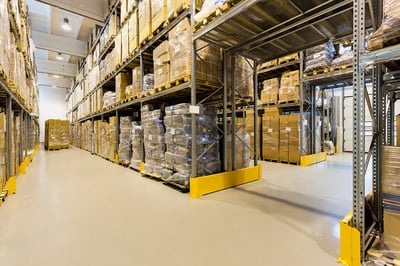Lurking in the bowels of your facility may be a silent destroyer of your company balance sheet … expired, obsolete, damaged or unsellable inventory.
There are many reasons why companies hold onto old inventory, but few realize the costs and damage that is happening when those products sit in the back corner of a warehouse.
Let’s dive into:
- The reasons behind why businesses hold onto obsolete inventory
- The risks of holding onto obsolete products
- The tax implications that may cause you to rethink your next move
- Who can help you get rid of inventory you no longer want
Why Are You Holding Onto Obsolete Inventory?

Industry experts estimate that holding onto obsolete inventory can cost the typical distributor 25% per year. In other words, if you have $100,000 in product you can no longer sell, holding onto it will cost you $25,000 in storage, insurance and depreciation.
Some common obsolete products tucked away in warehouses today include:
- Electronics, like digital cameras, TVs, computers, blu ray discs and even older products like vhs tapes, video cassettes, cassette tapes and overhead projectors
- Retail merchandise, like out-of-season clothing, outdated fashion accessories and unsold promotional items
- Industrial components, like outdated machinery parts, surplus tools and old manufacturing equipment
- Expired products, like pharmaceuticals, cosmetics, food and beverage, and over-the-counter medications
- Construction materials, like leftover building supplies and paint
- Medical equipment, like outdated diagnostic devices, old medical instruments and surplus hospital supplies
So why do many businesses hold on to inventory they no longer need or can sell for a profit? Some products may have been “sure things” that were aggressively procured or manufactured. Items may line shelves because they were over forecasted by sales departments, or did not sell for a variety of reasons.
Some of these products may have been overly technical for mass consumption, required sales and marketing investment that exceeded their margins, or some were just bad design or had bugs leading to heavy returns.
Business owners may hold onto these products because they’re hopeful dreamers that someday they’ll be able to recoup their investment. They may also fear the potential loss of value from selling at a significant discount, or believe that they can use the products in a different way than they were intended down the road.
What Are The Risks Of Holding Onto Obsolete Products?
There are several risks or drawbacks to holding onto obsolete products. Some of these include:
- Increased storage costs
- Depreciation that leads to greater financial losses
- Capital tied up in obsolete inventory
- Added insurance costs without generating any revenue
- A loss of valuable warehouse space
- Tax implications, such as losing the ability to write-off losses (more on this below)
- Market perceptions (holding on to outdated products can make a business seem out of touch with current trends and innovations)
There’s another significant risk of holding onto obsolete products that businesses should be aware of: The grey market.
The grey market, often referred to as the parallel market, involves the trade of goods through distribution channels that are legal but unofficial, unauthorized or unintended by the original manufacturer. Unlike the black market, where the trade is illegal and involves contraband goods, the gray market deals with legitimate products sold outside the sanctioned retail channels.
This market can cover a wide range of products, including electronics, pharmaceuticals and luxury goods, offering them at lower prices than those found in official stores. The existence of the gray market can present challenges for manufacturers and consumers alike.
Obsolete items may find their way into the gray market as businesses seek to recoup some of the investments tied up in outdated or slow-moving inventory. Products may also end up on the grey market and in the wrong hands if a business doesn’t securely discard obsolete products, or if employees take products from a storage facility, assuming that no one will notice they are missing.
Sellers on the grey market may market these products as new versions, fooling consumers into thinking they’re getting legitimate or updated items at a reduced price. In reality, it may be a good deal to the person selling the item on the grey market, but a bad deal for the manufacturer and consumer.
Particularly for manufacturers, the gray market can dilute brand value and disrupt authorized sales channels, complicating efforts to maintain consistent pricing and customer service standards.
What Are The Tax Implications
As we mentioned above, there are also tax implications to holding onto obsolete products. Understanding these implications is crucial for making informed decisions about inventory management and financial planning.
implications is crucial for making informed decisions about inventory management and financial planning.
Here are five tax implications that may cause you to rethink what you do with your obsolete inventory:
- Inventory Valuation and Write-Downs: The value of obsolete inventory must be accurately reflected in a company’s financial statements. Businesses are often required to write down the value of obsolete inventory to its current market value. This write-down can reduce the taxable income for the period, as the loss on inventory is recognized as an expense. However, it also means the business must acknowledge the reduced asset value on its balance sheet.
- Carrying Costs and Tax Deductions: The ongoing costs of storing obsolete inventory, such as warehousing, insurance and maintenance, are generally deductible expenses. These deductions can lower taxable income, providing some financial relief. Nevertheless, these carrying costs represent a continuous drain on resources without generating revenue.
- Potential Tax Benefits of Disposal: Disposing of obsolete inventory, either by selling at a discount, donating or scrapping, can have different tax consequences. Donating obsolete inventory to a qualified charitable organization can provide a tax deduction based on the fair market value of the donated goods, subject to certain limitations and documentation requirements. Scrapping or selling at a loss can also generate tax-deductible losses, which can offset other taxable income.
- Impact on Financial Ratios and Tax Liability: Holding onto obsolete inventory affects financial ratios such as inventory turnover and current ratio. Poor financial ratios can influence the perception of financial health and creditworthiness, potentially impacting tax planning strategies. For instance, high levels of obsolete inventory might necessitate more conservative tax positions or influence decisions on deferring or accelerating income and expenses.
- Tax Implications of Inventory Method: The method of inventory accounting (e.g., FIFO, LIFO, weighted average) can affect how obsolete inventory is valued and taxed. For instance, using LIFO (Last In, First Out) may result in higher write-downs during periods of rising prices, impacting taxable income differently than FIFO (First In, First Out).
The tax implications of holding onto obsolete products are multifaceted, influencing inventory valuation, deductible expenses, disposal strategies, financial ratios and overall tax liability. Businesses must navigate these complexities carefully, often with the guidance of tax professionals, to optimize their tax positions and minimize the financial burden of obsolete inventory.
If you find that it’s in your company’s best interest to discard any obsolete products you have in storage, let’s explore next who can help.
Who Can Help Get Rid Of Your Obsolete Inventory?
If you have inventory in your facility that is not of interest to a liquidator or charity, certified product disposal may be your best bet to maximize any possible tax deduction.
Certified product disposal is a process whereby products are destroyed or disposed of and the process is authenticated, often using a certificate of destruction template or by providing photographic evidence. Certified product destruction is widely used across many industries, from pharmaceuticals to electronics, apparel, and food and beverage.
What makes certified product disposal different from routine trash disposal? Certified product disposal involves a formal, documented process that ensures products are destroyed in a controlled and verifiable manner. The destruction process is typically monitored and authenticated to guarantee that the products are irreversibly destroyed, preventing any possibility of them re-entering the market.
In contrast, routine trash disposal lacks this rigorous documentation and verification. Routine disposal simply involves discarding items without any formal process to ensure they are destroyed or rendered unusable. This can lead to some of the risks we outlined above, such as unauthorized resale, environmental harm or non-compliance with legal and regulatory requirements.
Certified product destruction services are particularly important for industries in the United States that handle sensitive or high-value products, such as pharmaceuticals, electronics, and food and beverage, where improper disposal could lead to safety issues, brand damage or legal liabilities. The certified process ensures that the disposal of products meets all relevant standards and regulations, providing assurance to stakeholders that products are managed responsibly.
Qualified product disposal companies will provide you with the necessary assurances that the job is being handled properly. If your facility has obsolete products on hand, now might be the right time to clean up your facility and improve your balance sheet.


Comment